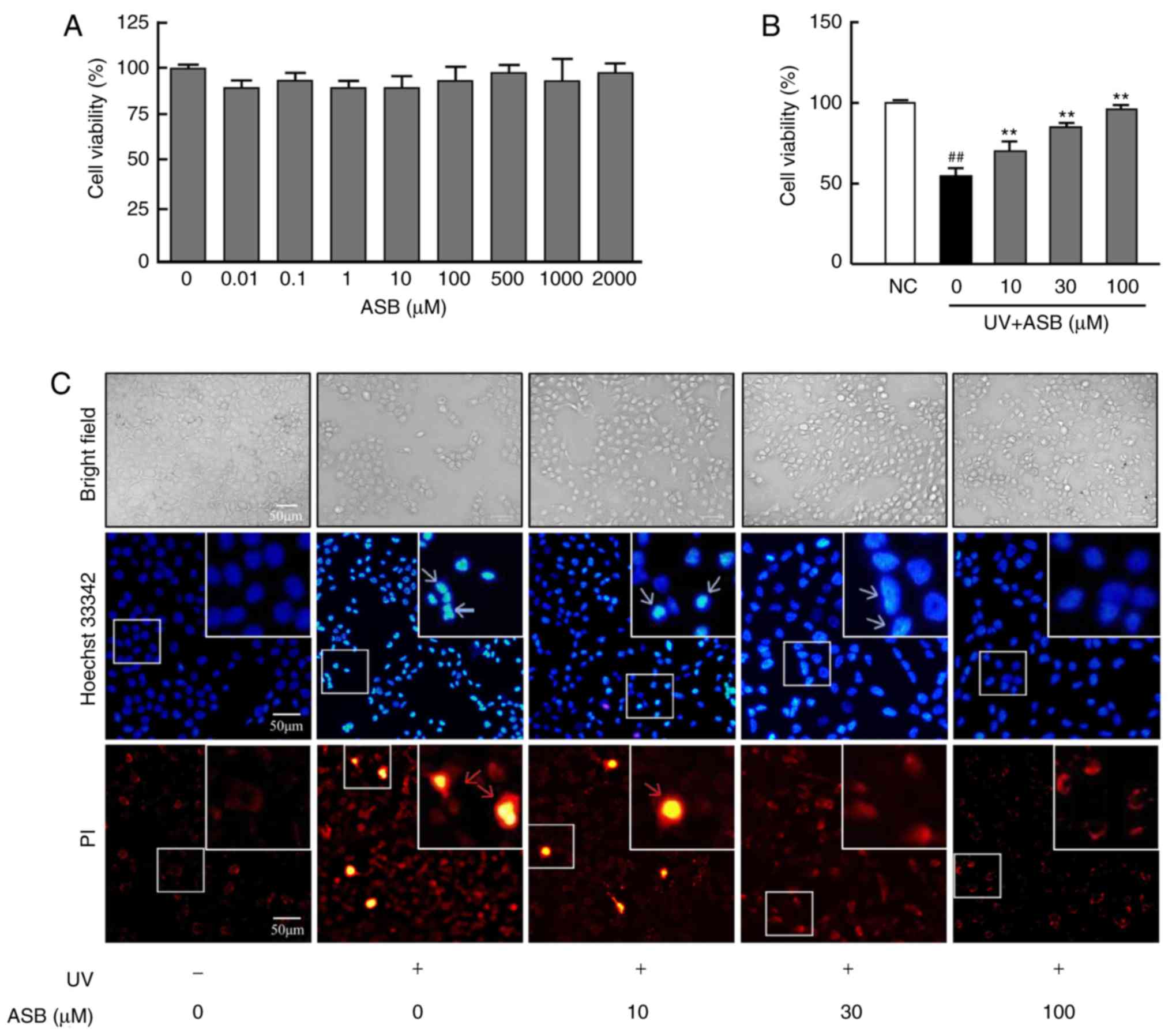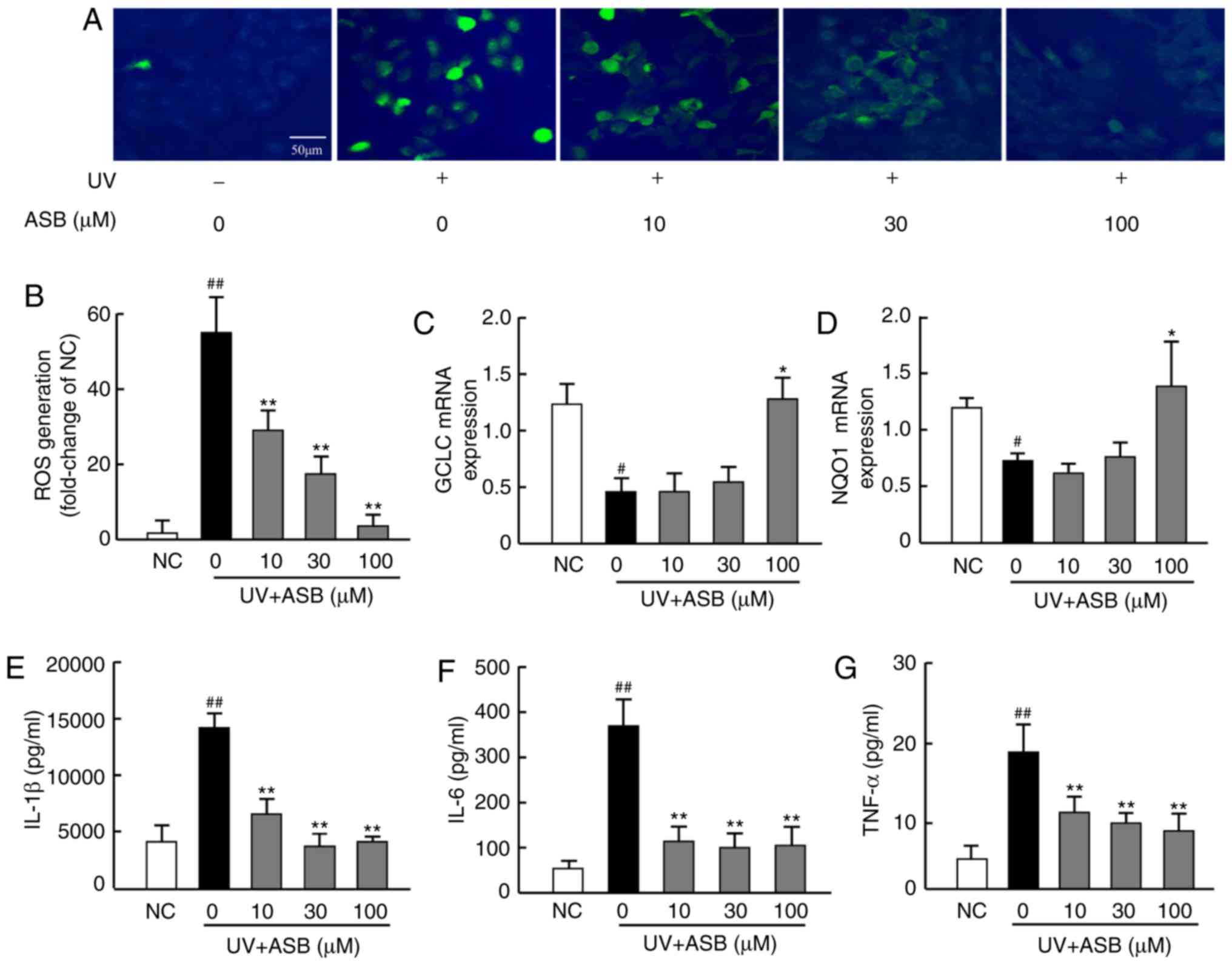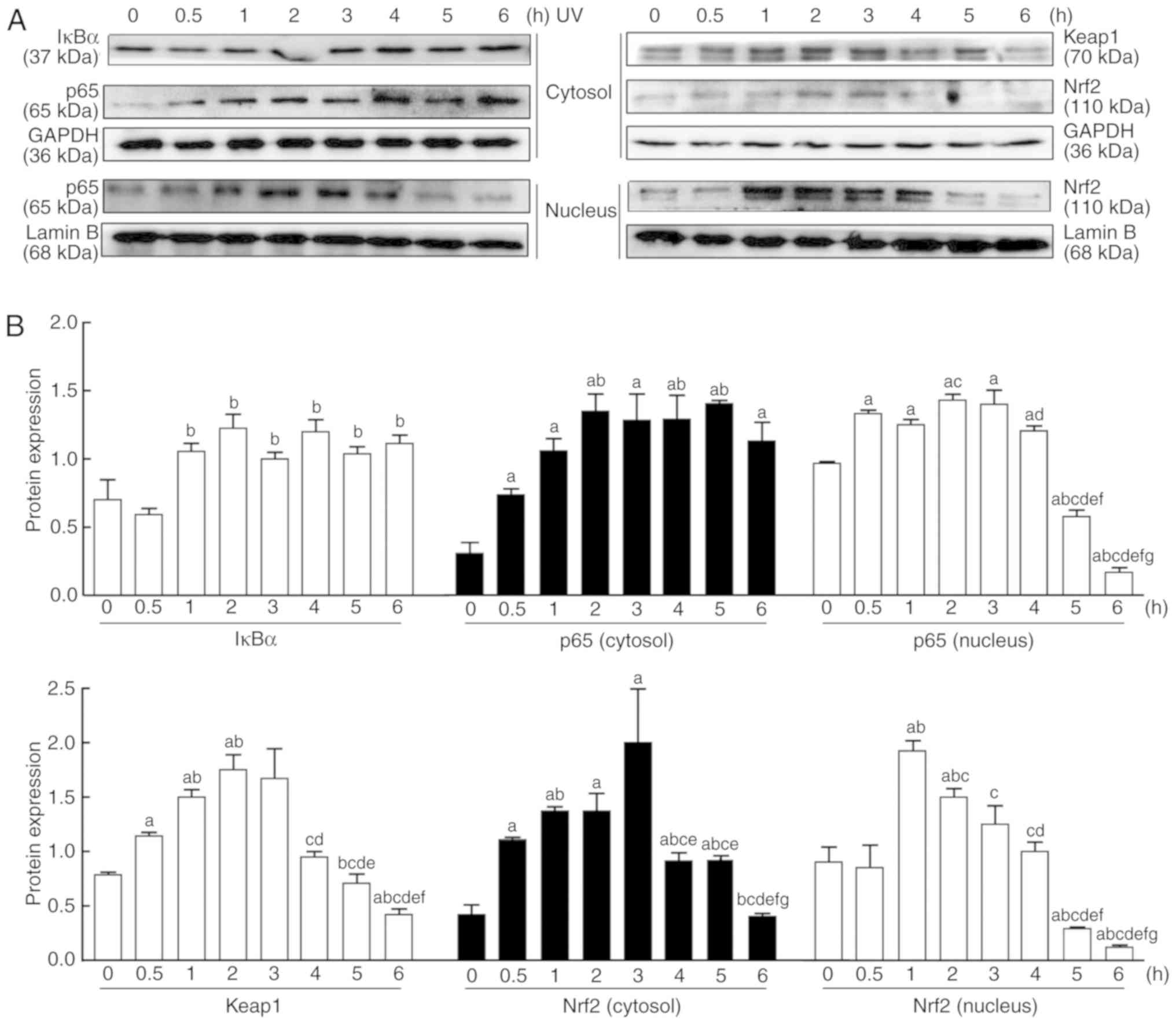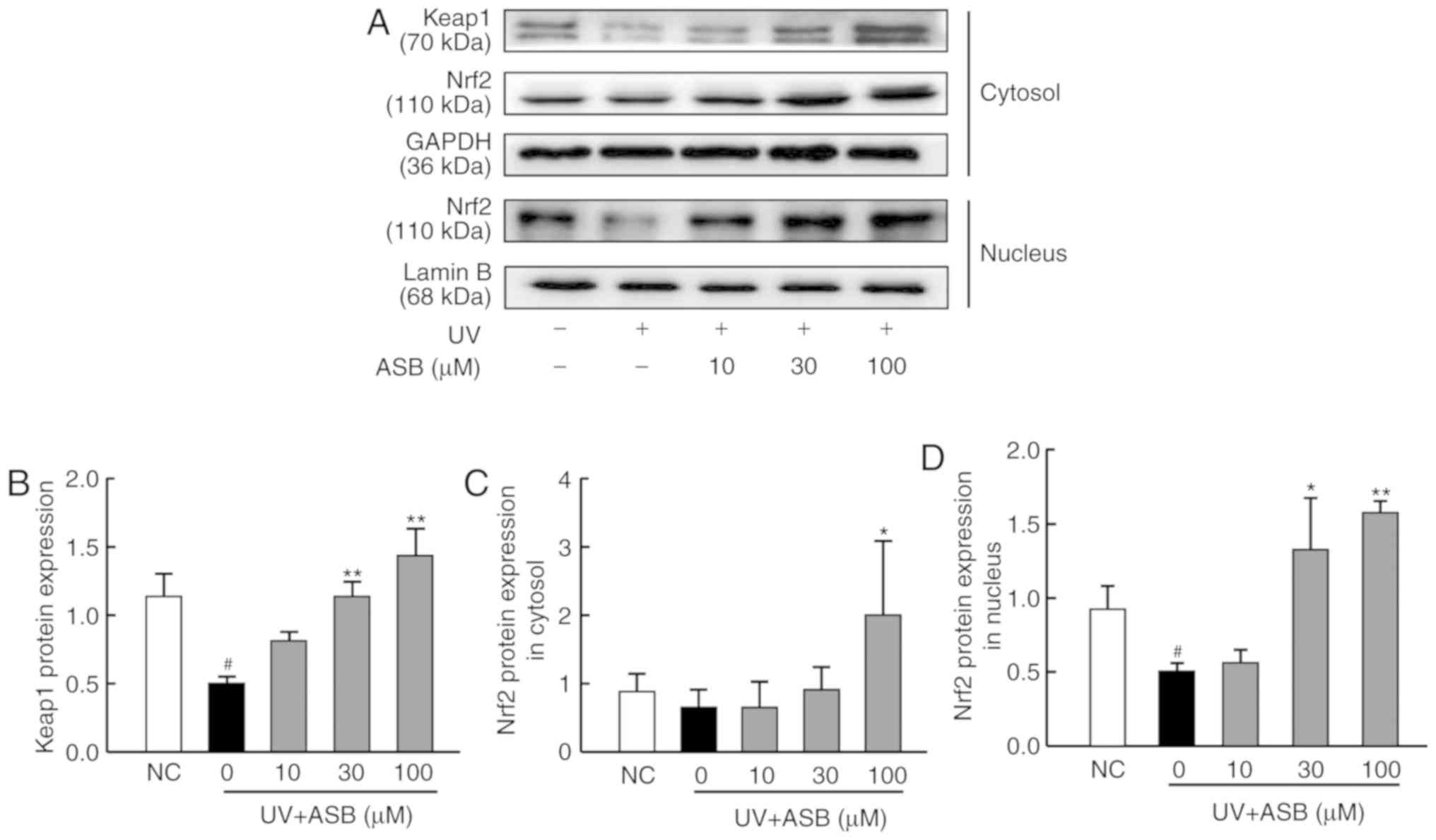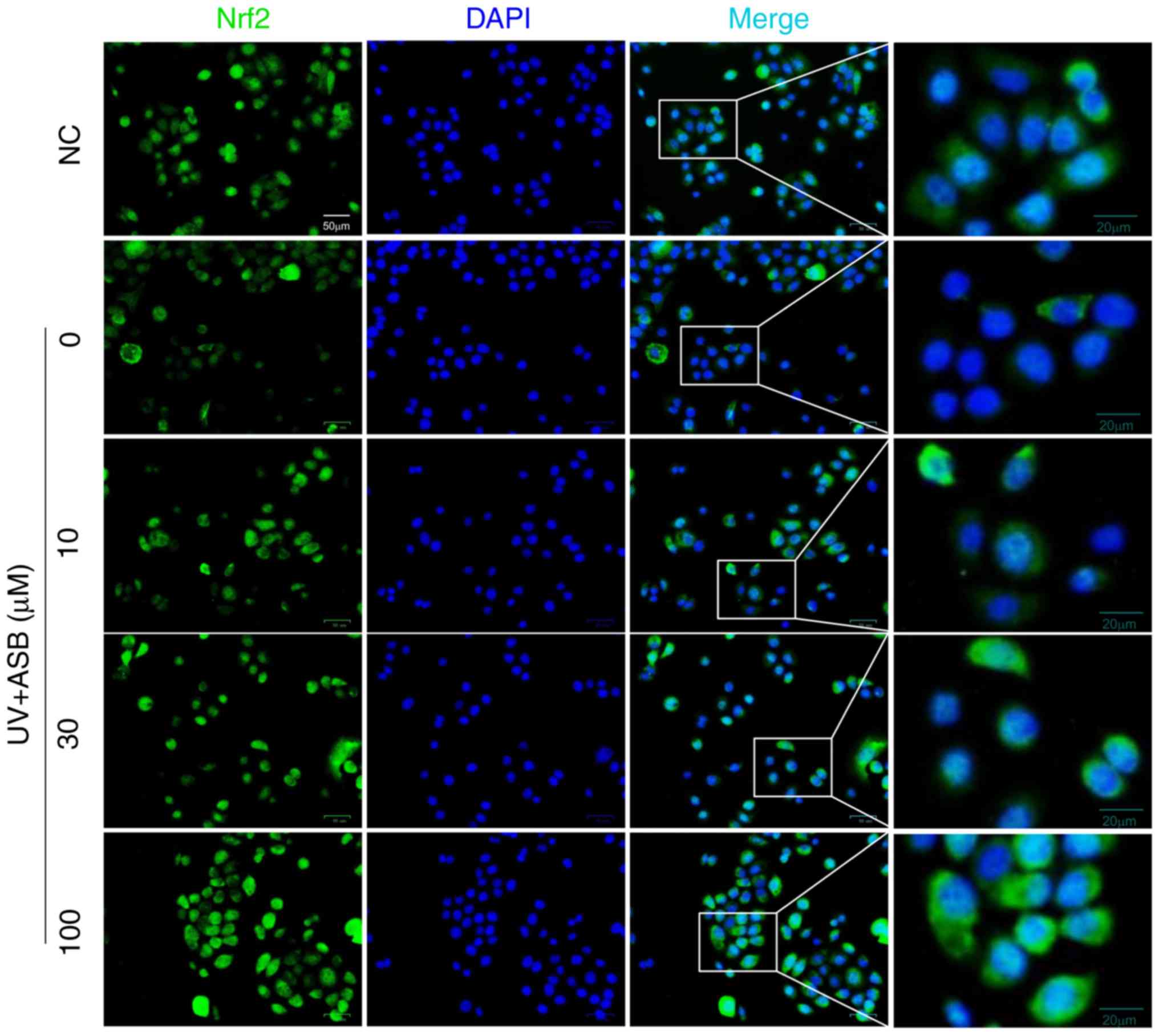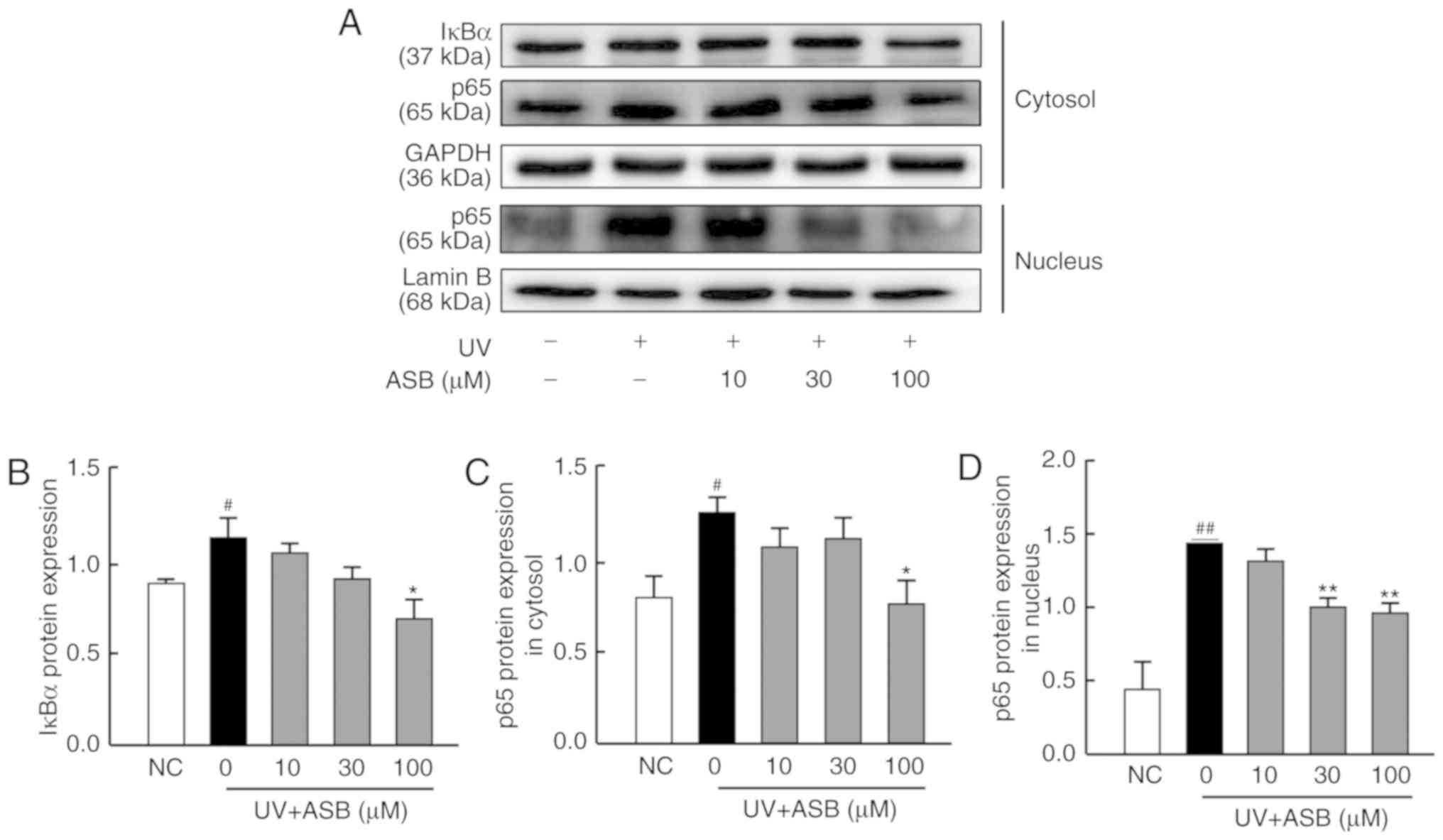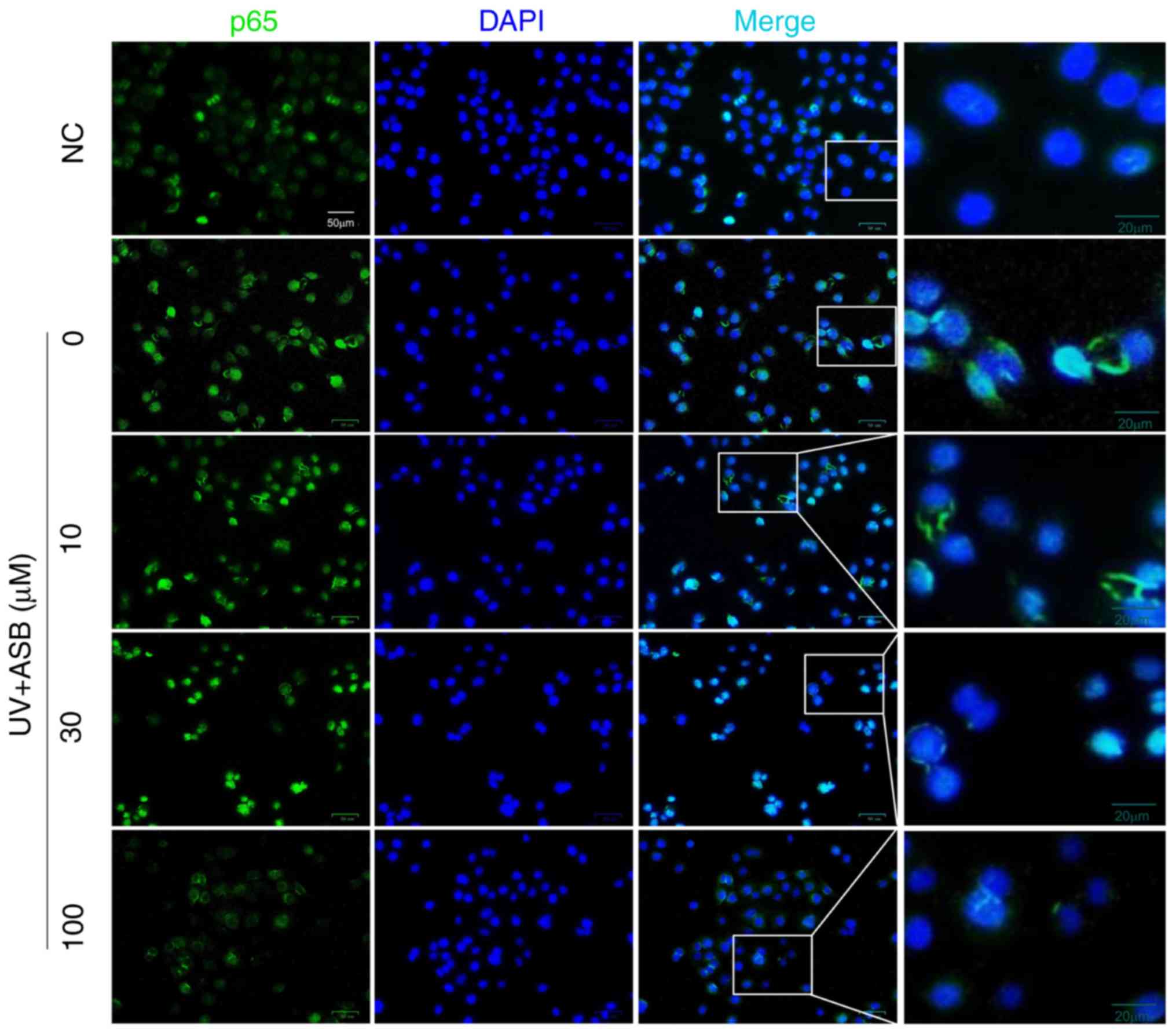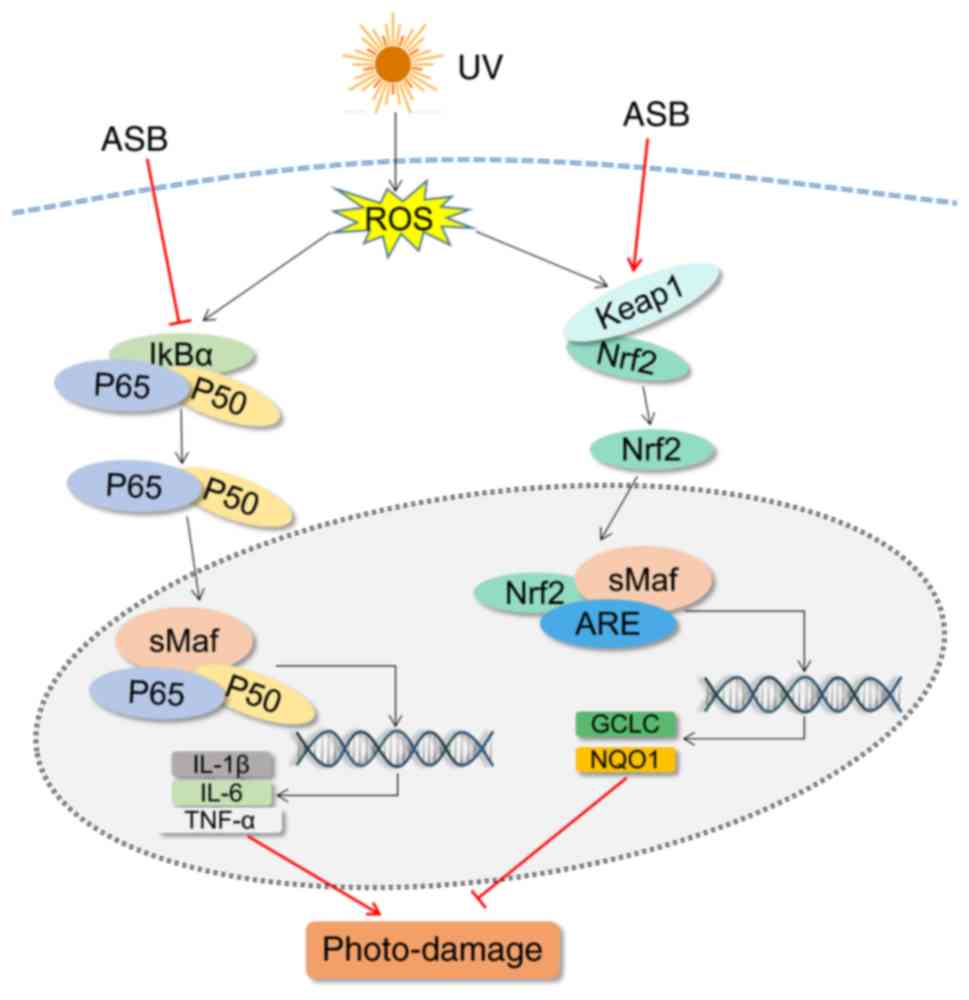|
1
|
Battie C and Verschoore M: Cutaneous solar
ultraviolet exposure and clinical aspects of photodamage. Indian J
Dermatol Venereol Leprol. 78(Suppl 1): S9–S14. 2012. View Article : Google Scholar : PubMed/NCBI
|
|
2
|
Ogden S, Samuel M and Griffiths CE: A
review of tazarotene in the treatment of photodamaged skin. Clin
Interv Aging. 3:71–76. 2008. View Article : Google Scholar : PubMed/NCBI
|
|
3
|
Kageyama H and Waditee-Sirisattha R:
Antioxidative, anti-inflammatory, and anti-aging properties of
mycosporine-like amino acids: Molecular and cellular mechanisms in
the protection of skin-aging. Mar Drugs. 17:E2222019. View Article : Google Scholar : PubMed/NCBI
|
|
4
|
Puizina-Ivić N: Skin aging. Acta
Dermatovenerol Alp Pannonica Adriat. 17:47–54. 2008.
|
|
5
|
Wu SL, Li H, Zhang XM and Li ZF: Optical
features for chronological aging and photoaging skin by optical
coherence tomography. Lasers Med Sci. 28:445–450. 2013. View Article : Google Scholar
|
|
6
|
Schuch AP, Moreno NC, Schuch NJ, Menck CFM
and Garcia CCM: Sunlight damage to cellular DNA: Focus on
oxidatively generated lesions. Free Radic Biol Med. 107:110–124.
2017. View Article : Google Scholar : PubMed/NCBI
|
|
7
|
Kim HK: Protective effect of garlic on
cellular senescence in UVB-exposed HaCaT human keratinocytes.
Nutrients. 8:E4642016. View Article : Google Scholar : PubMed/NCBI
|
|
8
|
Zhang JX, Wang XL, Vikash V, Ye Q, Wu D,
Liu Y and Dong W: ROS and ROS-mediated cellular signaling. Oxid Med
Cell Longev. 2016:43509652016. View Article : Google Scholar : PubMed/NCBI
|
|
9
|
Lee B, Moon KM, Son S, Yun HY, Han YK, Ha
YM, Kim DH, Chung KW, Lee EK, An HJ, et al: (2R/S,4R)-2-
(2,4-Dihydroxyphenyl)thiazolidine-4-carboxylic acid prevents
UV-induced wrinkle formation through inhibiting NF-κB-mediated
inflammation. J Dermatol Sci. 79:313–316. 2015. View Article : Google Scholar : PubMed/NCBI
|
|
10
|
Pires BRB, Silva RCMC, Ferreira GM and
Abdelhay E: NF-kappaB: Two sides of the same coin. Genes (Basel).
9:E242018. View Article : Google Scholar
|
|
11
|
Kim M, Park YG, Lee HJ, Lim SJ and Nho CW:
Youngiasides A and C isolated from youngia denticulatum inhibit
UVB-induced MMP expression and promote type I procollagen
production via repression of MAPK/AP-1/NF-κB and activation of
AMPK/Nrf2 in HaCaT cells and human dermal fibroblasts. J Agric Food
Chem. 63:5428–5438. 2015. View Article : Google Scholar : PubMed/NCBI
|
|
12
|
Muzaffer U, Paul VI, Prasad NR,
Karthikeyan R and Agilan B: Protective effect of juglans regia L.
Against ultraviolet B radiation induced inflammatory responses in
human epidermal keratinocytes. Phytomedicine. 42:100–111. 2018.
View Article : Google Scholar : PubMed/NCBI
|
|
13
|
Kim S and Chung JH: Berberine prevents
UV-induced MMP-1 and reduction of type I procollagen expression in
human dermal fibroblasts. Phytomedicine. 15:749–753. 2008.
View Article : Google Scholar : PubMed/NCBI
|
|
14
|
Thimmulappa RK, Lee H, Rangasamy T, Reddy
SP, Yamamoto M, Kensler TW and Biswal S: Nrf2 is a critical
regulator of the innate immune response and survival during
experimental sepsis. J Clin Invest. 116:984–995. 2006. View Article : Google Scholar : PubMed/NCBI
|
|
15
|
Schäfer M and Werner S: Nrf2-A regulator
of keratinocyte redox signaling. Free Radic Biol Med. 88(Pt B):
243–252. 2015. View Article : Google Scholar : PubMed/NCBI
|
|
16
|
Zhang DD and Hannink M: Distinct cysteine
residues in Keap1 are required for Keap1-dependent ubiquitination
of Nrf2 and for stabilization of Nrf2 by chemopreventive agents and
oxidative stress. Mol Cell Biol. 23:8137–8151. 2003. View Article : Google Scholar : PubMed/NCBI
|
|
17
|
Wang W, Guan C, Sun X, Zhao Z, Li J, Fu X,
Qiu Y, Huang M, Jin J and Huang Z: Tanshinone IIA protects against
acetaminophen-induced hepatotoxicity via activating the Nrf2
pathway. Phytomedicine. 23:589–596. 2016. View Article : Google Scholar : PubMed/NCBI
|
|
18
|
Hseu YC, Korivi M, Lin FY, Li ML, Lin RW,
Wu JJ and Yang HL: Trans-cinnamic acid attenuates UVA-induced
photoaging through inhibition of AP-1 activation and induction of
Nrf2-mediated antioxidant genes in human skin fibroblasts. J
Dermatol Sci. 90:123–134. 2018. View Article : Google Scholar : PubMed/NCBI
|
|
19
|
Saw CL, Huang MT, Liu Y, Khor TO, Conney
AH and Kong AN: Impact of Nrf2 on UVB-induced skin
inflammation/photo-protection and photoprotective effect of
sulforaphane. Mol Carcinog. 50:479–486. 2011. View Article : Google Scholar : PubMed/NCBI
|
|
20
|
Guo W, Liu W, Chen G, Hong S, Qian C, Xie
N, Yang X, Sun Y and Xu Q: Water-soluble andrographolide sulfonate
exerts anti-sepsis action in mice through down-regulating p38 MAPK,
STAT3 and NF-κB pathways. Int Immunopharmacol. 14:613–619. 2012.
View Article : Google Scholar : PubMed/NCBI
|
|
21
|
Lu H, Zhang XY, Zhou YQ, Wen X and Zhu LY:
Proteomic alterations in mouse kidney induced by andrographolide
sodium bisulfite. Acta Pharmacol Sin. 32:888–894. 2011. View Article : Google Scholar : PubMed/NCBI
|
|
22
|
Lu H, Zhang XY, Wang YQ, Zheng XL,
Yin-Zhao, Xing WM and Zhang Q: Andrographolide sodium
bisulfate-induced apoptosis and autophagy in human proximal tubular
endothelial cells is a ROS-mediated pathway. Environ Toxicol
Pharmacol. 37:718–728. 2014. View Article : Google Scholar : PubMed/NCBI
|
|
23
|
Liang E, Liu X, Du Z, Yang R and Zhao Y:
Andrographolide ameliorates diabetic cardiomyopathy in mice by
blockage of oxidative damage and NF-κB-mediated inflammation. Oxid
Med Cell Longev. 2018:90867472018. View Article : Google Scholar
|
|
24
|
Zhan JYX, Wang XF, Liu YH, Zhang ZB, Wang
L, Chen JN, Huang S, Zeng HF and Lai XP: Andrographolide sodium
bisulfate prevents UV-induced skin photoaging through inhibiting
oxidative stress and inflammation. Mediat Inflamm.
2016:32714512016. View Article : Google Scholar
|
|
25
|
Sun S, Jiang P, Su W, Xiang Y, Li J, Zeng
L and Yang S: Wild chrysanthemum extract prevents UVB
radiation-induced acute cell death and photoaging. Cytotechnology.
68:229–240. 2016. View Article : Google Scholar :
|
|
26
|
Li H, Gao A, Jiang N, Liu Q, Liang B, Li
R, Zhang E, Li Z and Zhu H: Protective effect of curcumin against
acute ultraviolet B irradiation-induced photo-damage. Photochem
Photobiol. 92:808–815. 2016. View Article : Google Scholar : PubMed/NCBI
|
|
27
|
Gong M, Zhang P, Li C, Ma X and Yang D:
Protective mechanism of adipose-derived stem cells in remodelling
of the skin stem cell niche during photoaging. Cell Physiol
Biochem. 51:2456–2471. 2018. View Article : Google Scholar : PubMed/NCBI
|
|
28
|
Cuadrado A, Martin-Moldes Z, Ye J and
Lastres-Becker I: Transcription factors NRF2 and NF-κB are
coordinated effectors of the Rho family, GTP-binding protein RAC1
during inflammation. J Biol Chem. 289:15244–15258. 2014. View Article : Google Scholar : PubMed/NCBI
|
|
29
|
Xian DH, Gao XQ, Xiong X, Xu J, Yang L,
Pan L and Zhong J: Photoprotection against UV-induced damage by
skin-derived precursors in hairless mice. J Photochem Photobiol B.
175:73–82. 2017. View Article : Google Scholar : PubMed/NCBI
|
|
30
|
Feng XX, Yu XT, Li WJ, Kong SZ, Liu YH,
Zhang X, Xian YF, Zhang XJ, Su ZR and Lin ZX: Effects of topical
application of patchouli alcohol on the UV-induced skin photoaging
in mice. Eur J Pharm Sci. 63:113–123. 2014. View Article : Google Scholar : PubMed/NCBI
|
|
31
|
Pollet M, Shaik S, Mescher M, Frauenstein
K, Tigges J, Braun SA, Sondenheimer K, Kaveh M, Bruhs A, Meller S,
et al: The AHR represses nucleotide excision repair and apoptosis
and contributes to UV-induced skin carcinogenesis. Cell Death
Differ. 25:1823–1836. 2018. View Article : Google Scholar : PubMed/NCBI
|
|
32
|
Katsuoka F, Motohashi H, Ishii T,
Aburatani H, Engel JD and Yamamoto M: Genetic evidence that small
Maf proteins are essential for the activation of antioxidant
response element-dependent genes. Mol Cell Biol. 25:8044–8051.
2005. View Article : Google Scholar : PubMed/NCBI
|
|
33
|
Jastrzab A, Gegotek A and Skrzydlewska E:
Cannabidiol regulates the expression of keratinocyte proteins
involved in the inflammation process through transcriptional
regulation. Cells. 8:E8272019. View Article : Google Scholar : PubMed/NCBI
|
|
34
|
Yan H, Huang Z, Bai Q, Sheng Y, Hao Z,
Wang Z and Ji L: Natural product andrographolide alleviated
APAP-induced liver fibrosis by activating Nrf2 antioxidant pathway.
Toxicology. 396-397:1–12. 2018. View Article : Google Scholar : PubMed/NCBI
|
|
35
|
Herpers B, Wink S, Fredriksson L, Di Z,
Hendriks G, Vrieling H, de Bont H and van de Water B: Activation of
the Nrf2 response by intrinsic hepatotoxic drugs correlates with
suppression of NF-κB activation and sensitizes toward TNFα-induced
cytotoxicity. Arch Toxicol. 90:1163–1179. 2016. View Article : Google Scholar
|
|
36
|
Chiou YS, Huang QR, Ho CT, Wang YJ and Pan
MH: Directly interact with Keap1 and LPS is involved in the
anti-inflammatory mechanisms of (-)-epicatechin-3-gallate in
LPS-induced macrophages and endotoxemia. Free Radic Biol Med.
94:1–16. 2016. View Article : Google Scholar : PubMed/NCBI
|
|
37
|
Liu GH, Qu J and Shen X: NF-kappaB/p65
antagonizes Nrf2-ARE pathway by depriving CBP from Nrf2 and
facilitating recruitment of HDAC3 to MafK. Biochim Biophys Acta.
1783:713–727. 2008. View Article : Google Scholar : PubMed/NCBI
|
|
38
|
Yu M, Li H, Liu Q, Liu F, Tang L, Li C,
Yuan Y, Zhan Y, Xu W, Li W, et al: Nuclear factor p65 interacts
with Keap1 to repress the Nrf2-ARE pathway. Cell Signal.
23:883–892. 2011. View Article : Google Scholar : PubMed/NCBI
|
|
39
|
Pan H, Wang H, Wang X, Zhu L and Mao L:
The absence of Nrf2 enhances NF-κB-dependent inflammation following
scratch injury in mouse primary cultured astrocytes. Mediators
Inflamm. 2012:2175802012. View Article : Google Scholar
|
|
40
|
Cheung KL and Kong AN: Molecular targets
of dietary phenethyl isothiocyanate and sulforaphane for cancer
chemoprevention. AAPS J. 12:87–97. 2010. View Article : Google Scholar :
|
|
41
|
Buelna-Chontal M and Zazueta C: Redox
activation of Nrf2 and NF-κB: A double end sword? Cell Signal.
25:2548–2557. 2013. View Article : Google Scholar : PubMed/NCBI
|















